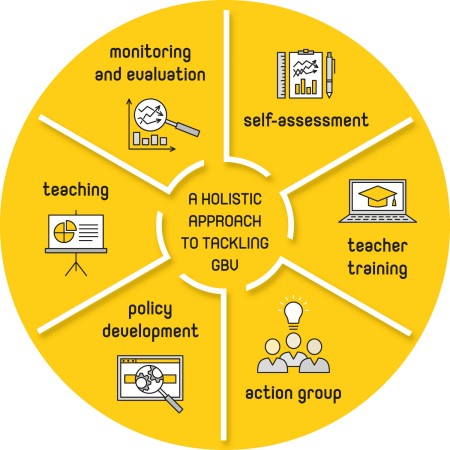What is ESAS?
Equally Safe at School (ESAS) was developed in partnership with schools to help prevent and tackle gender-based violence (GBV). It is a whole school approach, which supports schools to embed a set of holistic measures across every aspect of school life. Implementation of the intervention enables schools to continually build and reinforce messages that challenge violence and promote gender equality – across the curriculum, in everyday interactions between staff and students, in policies and procedures and in the culture and ethos of the school community.

The ESAS intervention incorporates the following holistic measures:
- Whole school assessments to find out what the main issues are in your school community through focus groups and surveys with students and staff
- A student-led action group where students and staff work together to plan actions to improve their school culture
- Teacher training to equip teachers with knowledge about GBV and the skills they need to prevent and respond to it
- Policy development that makes sure school policies relating to GBV are clear, comprehensive and effective
- Teaching resources to help ensure that the curriculum includes learning about gender equality and GBV
- Monitoring progress to find out how well activities are working and how to sustain progress
The website has been designed to make activities as straightforward and achievable as possible, and to enable senior management to lead, delegate, monitor and report on progress easily. Schools will make the best progress if they think about ESAS in a holistic way and carry out all the activities involved; however they can choose to take a lighter-touch approach, utilising whichever tools best suit their needs.
ESAS Theory of Change
The Equally Safe Theory of Change explains how the intervention works. It starts with the problem (gender-based violence in school), describes the ESAS activities, and shows what results are intended from these activities.
Schools can monitor their progress against these intended results using the student and staff surveys which they will find in the monitoring and evaluation section of My ESAS, after they have registered an account.
The Theory of Change also describes the school-level conditions for success. These key conditions are:
- that schools recognise GBV as an issue
- they believe ESAS is important
- they allocate time and resources
- support the teachers leading on ESAS activities
- prioritise staff training
The Theory of Change can be used to explain ESAS to staff, students, parents/carers and other partners.
It was originally designed in 2016 after the initial ESAS scoping study. Since then, it has regularly been updated based on learning from project implementation and research during the pilot phase. This version is based on the latest evidence from the Equally Safe research.
View the Theory of Change in a new tab
You can also access a pdf version here.